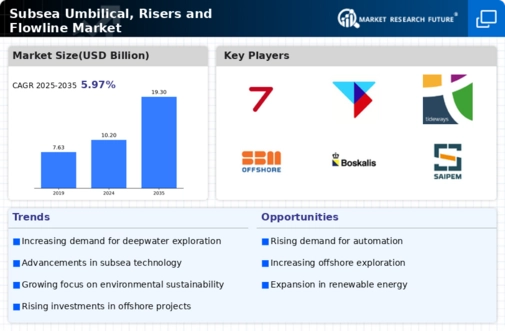Rising Energy Demand
The Subsea Umbilical, Risers and Flowline Market is significantly influenced by the rising global energy demand. As populations grow and economies develop, the need for reliable energy sources intensifies. This demand is particularly pronounced in emerging markets, where energy consumption is expected to increase dramatically. The International Energy Agency projects that global energy demand could rise by over 25 percent by 2040. Consequently, energy companies are investing heavily in subsea technologies to ensure efficient extraction and transportation of hydrocarbons. This trend is likely to drive the growth of the subsea umbilicals, risers, and flowlines market, as these components are critical for meeting the increasing energy needs.
Focus on Environmental Sustainability
The Subsea Umbilical, Risers and Flowline Market is increasingly influenced by the focus on environmental sustainability. As the world shifts towards cleaner energy sources, there is a growing emphasis on minimizing the environmental impact of subsea operations. Companies are investing in technologies that reduce emissions and enhance the efficiency of subsea systems. This trend is evident in the development of eco-friendly materials for umbilicals and risers, which aim to reduce the carbon footprint of offshore projects. Furthermore, the push for sustainable practices is likely to drive innovation within the subsea umbilicals, risers, and flowlines market, as stakeholders seek to align with global sustainability goals.
Regulatory Support for Offshore Projects
The Subsea Umbilical, Risers and Flowline Market is benefiting from increasing regulatory support for offshore projects. Governments are recognizing the importance of energy security and are implementing policies that facilitate offshore exploration and production. This regulatory environment is encouraging investments in subsea infrastructure, as companies seek to comply with safety and environmental standards. Additionally, incentives for renewable energy projects are also influencing the subsea market, as hybrid systems that combine traditional and renewable energy sources become more prevalent. This supportive regulatory framework is likely to enhance the growth prospects of the subsea umbilicals, risers, and flowlines market.
Increasing Offshore Exploration Activities
The Subsea Umbilical, Risers and Flowline Market is experiencing a surge in offshore exploration activities, driven by the rising demand for oil and gas. As energy companies seek to tap into untapped reserves, the need for advanced subsea infrastructure becomes paramount. According to recent estimates, offshore exploration investments are projected to reach substantial figures, indicating a robust growth trajectory. This trend is likely to propel the demand for subsea umbilicals, risers, and flowlines, which are essential for connecting subsea facilities to surface platforms. The increasing complexity of offshore projects necessitates innovative solutions, thereby enhancing the market's potential.
Technological Innovations in Subsea Systems
Technological advancements are playing a crucial role in shaping the Subsea Umbilical, Risers and Flowline Market. Innovations such as enhanced materials, improved design methodologies, and advanced monitoring systems are enabling more efficient and reliable subsea operations. For instance, the development of flexible risers and umbilicals has allowed for greater adaptability in challenging environments. Furthermore, the integration of digital technologies, such as IoT and AI, is enhancing operational efficiency and safety. As these technologies continue to evolve, they are expected to drive the demand for subsea umbilicals, risers, and flowlines, thereby contributing to the overall growth of the market.

























Leave a Comment